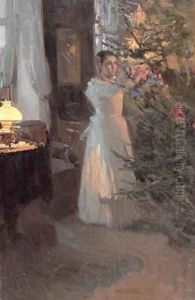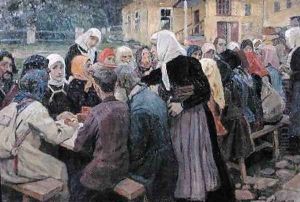Alexei Mikhailovich Korin Paintings
Alexei Mikhailovich Korin was a distinguished Russian painter and graphic artist, born in 1865 in the town of Palekh, then part of the Russian Empire. He hailed from a family deeply entrenched in the tradition of icon painting, which significantly influenced his artistic development from an early age. His brother, Konstantin Korin, also became a well-known artist, suggesting a familial environment rich in artistic stimulation and encouragement. Alexei Korin embarked on his formal art education at the Moscow School of Painting, Sculpture and Architecture, one of the premier art institutions in Russia, where he was mentored by some of the most prominent Russian artists of the time, including Abram Arkhipov and Alexei Savrasov.
Korin's career spanned a period of great change in Russia, from the final years of Tsarist rule through the revolutionary upheavals of the early 20th century to the establishment of the Soviet Union. Despite these turbulent times, he managed to achieve considerable recognition for his work, which was deeply rooted in the Russian realist tradition but also displayed elements of impressionism and Art Nouveau. He was particularly noted for his genre paintings, portraits, and landscapes, which often depicted the Russian countryside and peasant life, imbuing them with a sense of romanticism and nostalgia.
Throughout his career, Korin participated in numerous exhibitions, both in Russia and abroad, and became a member of various prestigious art societies, including the Peredvizhniki (Wanderers), a group of realist artists who sought to engage directly with the social and cultural issues of their day through their art. His works were widely collected and are represented in several major Russian museums, including the Tretyakov Gallery in Moscow and the Russian Museum in St. Petersburg.
Alexei Mikhailovich Korin's contribution to Russian art was not only in his paintings but also in his teaching. After the Russian Revolution, he was involved in the reorganization of art education in the country, contributing to the development of new generations of Russian artists. He died in 1923, leaving behind a legacy that has continued to influence Russian art to this day. His dedication to portraying the beauty and complexity of Russian life, combined with his technical mastery and innovative approach to color and form, ensure his place among the notable artists of his era.

